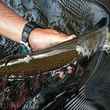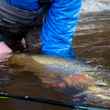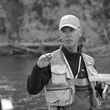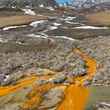I’d been on a Jim Harrison binge in the wake of his death—easy to do given his prodigious output. In particular, I’d been enjoying the stuff set in Michigan’s Upper Peninsula and two recurring characters, both classic Harrison anti-heroes, who hail from that land lost in time: Sunderson, the retired cop and borderline alcoholic who still carries a torch for his ex-wife but doesn’t let that deter him from bedding everything in sight; and Brown Dog, the irrepressibly raffish vagabond of mixed Finnish and Chippewa ancestry who lives entirely “off the grid” and is, if anything, even more priapic than Sunderson.
Indeed, the only activity whose rewards rival sex for this pair, or that commands a comparable percentage of their attention, is trout fishing. The events that propel the novel The Big Seven are set in motion when Sunderson buys a cabin on a trout stream, while in the novella “Brown Dog Redux” Harrison writes of the title character “He was observant of the multiple torments people seemed to have daily and felt lucky that he could resolve his own problems with a couple of beers and a half dozen hours of trout fishing…”
It’s also the case that while their tastes in trout (as in women) are catholic, given their druthers they’ll take brookies every time.
All of which helps explain why brook trout had been on my mind even more than usual—and why, when I stopped at the fly shop for a couple spools of tippet material and heard a guy off-handedly mention that he’d caught “big brookies” in a certain northern Wisconsin stream, I locked on like a pointer with a noseful of quail. Still, I tried to tamp down my excitement and play it cool, hoping that by feigning indifference I might finesse a few instructive details out of him, if not the GPS coordinates.
I needn’t have been so cagey. As if it were some terrible secret that he couldn’t wait to unburden himself of, the guy not only told me the name of the town closest to the good water but pulled up a picture of the stream on his phone!
More Like This
The photo showed a pretty boulder garden of moderate gradient flanked by wooded banks that looked to be at least 30 feet apart—plenty wide enough to wade and cast a fly, in other words. This is no small consideration in Wisconsin, where (as in Harrison’s U.P.) there are hundreds if not thousands of miles of brookie water but precious little of it is conducive to fly fishing, at least as the term is normally understood. Much of it is so brushily tight that even a bow-and-arrow cast is problematic.
“Great pocket water,” the guy said, expectantly.
“Yeah,” I replied, “I can see that.” I was already riffling through my mental calendar trying to determine which obligations I could juggle, cancel, or simply duck in order to wet my waders there ASAP. And I was already imagining myself swimming a Pass Lake, my go-to brookie pattern, through that murmuring, tea-colored water, tensed for that fist-tight boil and the tug on the end of my line.
As I close out my sixth decade and prepare to enter my seventh, I confess to knowing little more about women than I ever did. Of course this mystery is central to what makes them fascinating. They are not unlike trout streams in this respect—beguilingly enigmatic, predictable only to a point, and by turns generous with their favors and stingy with them. Sometimes your approach and presentation make all the difference, and sometimes they seem not to matter at all.
One thing I have determined, though—and it only took me 60 years to figure this out—is that the physical characteristic shared by the women I find most attractive is wide-set eyes.
Not what you were expecting, I know.
When I think of the women whose beauty makes me want to fall to my knees—Rita Hayworth, Emmylou Harris, one or two others whose names I dare not confess—this is the common denominator, the sine qua non. And while I can’t tell you much about the young woman who all but stopped my heart the moment I stepped into the convenience store where she was working, I can tell you that she had wide-set eyes.
Needing gas, I’d swung into the town my fly shop source had mentioned and, after almost driving past, located its lone C-store. The woman—barely more than a girl, really—was standing behind the counter, and her impact struck me like a physical blow. I had to force myself not to stare, but in the few seconds it took for me to ask where the rest room was, and for her to tell me, I noticed that those eyes were dark and almond-shaped, that her hair was jet-black and pulled behind her ears, and that her skin, the color of café au lait, conveyed such an impression of mousse-like moistness it looked as if it would swirl beneath the pressure of a fingertip. A Native American in her early 20s, she was absolutely breathtaking—and a woman of breathtaking beauty was absolutely the last thing I expected to see in that desolate place.
I knew of it by name but had never been there until that day. It proved to be one of those old logging towns of the kind you find scattered across the North Country from Maine to Minnesota—a boom town gone bust that limps along like a crippled dog, surviving for no apparent reason other than force of habit and, I suppose, human biology. To add another layer of misery, it lay in the pain shadow of a reservation that, like reservations everywhere, suffers from the litany of afflictions spawned by grinding poverty and pervasive, unrelieved hopelessness.
The irony, of course (it’s tempting to call it “tragic” but I think the tragedy lies elsewhere), is that more often than not it’s places like this—forgotten, on the road to nowhere, and with little else to recommend them—that are where the best brook trout fishing is found.
Naturally I wondered what the hell such a lovely creature was doing in this rathole, betraying in the wondering the prejudice toward physical beauty that permeates every nook and cranny of our culture—as if simply by being uncommonly attractive she somehow deserved “better.” It occurred to me, too, that Harrison, who wrote persuasively from the perspective of women in extremis, could have written a novel about this girl. Everything about her, and everything about this place (including its alleged trout stream), was right in his wheelhouse, a hanging curveball over the middle of the plate just begging to be knocked out of the park.
It hit me then, hard, that she could have been the model for Dalva, the eponymous heroine of the novel that I and many others consider Harrison’s masterpiece. She looked the part—as in direct from central casting—and it may be that that’s why I was so taken with her: She was the Dalva of my imagination made flesh.
That’s as far as it went, of course. I dawdled in the C-store for a while, pretending I was looking for something and finally buying an overpriced vanilla Bun Bar that I didn’t especially want. A purple-faced schlub sipping coffee from a styrofoam cup and ranting about “them Moslems” tried to get me to rise to the bait but I pretended not to hear him. I toyed with the idea of saying something to the girl—you know, some profundity like “Do you have any idea how gorgeous you are?”—but couldn’t think of any purpose it would serve other than to brand me in her mind as a pathetic old perv, undoubtedly one of the many who’d tried to hit on her over the years. One of the benefits of age is no longer giving a damn that you might be making a fool of yourself but you shouldn’t abuse the privilege.
So I paid for my candy bar, allowing my gaze to linger wistfully on the side of her face while she made change, knowing there was every chance in the world I’d never lay eyes on her again. Then, after consulting my Gazetteer for directions (I’m not really a GPS guy), I drove out of town, past the windowless taverns, the sad little houses, and the auto salvage yard that crowds the county highway, its heaped and rusting contents putting me in mind of the piled-up bones of bison.
Welcome to postcard-pretty northern Wisconsin. At least the sun was shining.
But it hadn’t been a day or two earlier, when heavy rains pounded the area. I located a couple road crossings where the touted stream looked promising but, swollen and running at a rate that induced a significant pucker factor, it rendered the idea of wadering-up a non-starter. Maybe I’d come back in the fall.
I made a strategic retreat, angling west and north along the ragged seam where hardscrabble dairy farms meet scruffy second-growth forest. My destination was a tributary whose flows, owing to the unique character of its watershed—ag land, mostly, and table flat at that—are about as stable as freestone streams can be. It’s also the single most reliable producer of brookies that I know, generous almost to a fault. The rains had left it a tick high and a touch off-color but whatever effect this had was likely to be positive.
I’d been depressed thinking about the girl’s bleak prospects in that shitheel town, also disappointed to find the new stream I’d been excited to try in unfishable condition, but now I felt the clouds begin to lift. I was in a familiar place, the portents were favorable, there was reason to believe I’d be rewarded.
I tied on a Pass Lake, stepped into the murmuring, tea-colored water, and started fishing, thankful to be on a stream that gave me plenty of room to cast.






























Comments